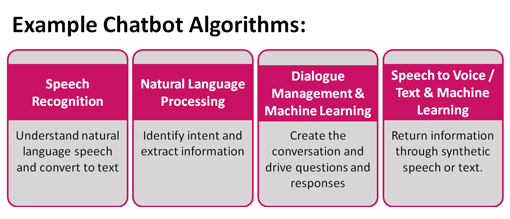Chatbots are becoming an essential tool for contact centres, helping to automate customer interactions and improve response times.
To function effectively, they rely on a variety of algorithms that process language, interpret intent, and generate appropriate replies.
Understanding these algorithms helps contact centres choose the right chatbot for their needs and improve the overall user experience.
To find out more about some of the algorithms chatbots use, we spoke to Steven Harris, Director, Strategic Clients at Odigo, and Stuart Dorman, Chief Innovation Officer at Sabio.
Video: What Algorithms Do Chatbots Use?
Watch the video below to hear Stuart and Steven explain some of the algorithms chatbots use:
With thanks to the following people for contributing to this video:
- Steven Harris, Director, Strategic Clients at Odigo
- Stuart Dorman, Chief Innovation Officer at Sabio
Five Algorithms Behind Chatbots
Chatbots rely on various algorithms to process and respond to user queries. These algorithms help the bot understand speech or text, interpret meaning, and generate appropriate responses.
The choice of algorithm depends on the chatbot’s purpose and the complexity of interactions it needs to handle, so let’s take a look at five common ones:
1. Speech Recognition
For voice-enabled chatbots, the first step is converting spoken language into text, as Stuart explains:
“The first thing you need to do is if your chatbot is voice enabled, you need to understand natural language speech and convert that to text. So speech recognition is the first step in that process”
Speech recognition algorithms analyse audio input and transcribe it into words the chatbot can process. This is essential for ensuring the chatbot accurately understands user requests.
2. Natural Language Processing (NLP)
“The second stage in the process is then taking that and applying natural language processing, which is a separate set of algorithms that is designed firstly to interpret the intent, i.e. the reason why the customer’s contacting, and then secondly, to extract useful pieces of information from the conversation, often called entities.
So these could be things like names, postcode, addresses, anything that’s useful to driving the conversation forward into achieving the outcome.
And also within that, you might have specific taxonomies that relate to your industry. So there might be certain language that’s used if you’re an insurer or a travel company or something like that.” – Stuart Dorman
Once the chatbot has the text input, NLP algorithms work to interpret the meaning behind it.
This involves:
- Intent Recognition – identifying why the user is interacting with the chatbot.
- Entity Extraction – pulling out key details like names, dates, or locations that help guide the conversation.
- Industry-Specific Language – understanding specialised terms relevant to the business sector.
“Natural language processing is absolutely key for chatbots, because it determines how the bot understands and interprets words. But it also aims to learn the intricacies of human language, including grammar, sentiment, intent and so on.” – Steven
3. Dialogue Management
Dialogue management controls how the chatbot interacts with users. It determines the structure of conversations, including the questions asked and the responses given.
“The third step in the process is dialogue management. And this is where you create the conversation and guide the customer towards the outcome.
So this is where you design the questions that you’re going to ask and the responses you give back to a certain question. Often machine learning is used here, where you can use a set of training data so you can give some sample questions, for example.
The machine learning algorithms can then use that as a basis to understand the hundreds of thousands of different ways that somebody could ask a question, without you having to pre-program every single one of those steps.” – Stuart
Machine learning plays a role here by allowing chatbots to recognise different ways a question could be phrased without requiring manual programming for each variation.
4. Text Classification and Neural Networks
Chatbots need to categorise text accurately to provide relevant responses, and according to Steven:
“When you give a chatbot a query, it needs to understand and have confidence that it understands that query. And chatbots use algorithms to do that. There are different types of algorithm with different strengths.
So, for example, chatbots that need to deal with a wide range of queries have to be good at classifying text and words into specific categories, so they can narrow down the possible range of responses.
A popular algorithm would be something like Naive Bayes, and that’s also good at determining how confident the chatbot is in its prediction.
There are other algorithms that are good at identifying the subject of a query, or neural networks, for example, that are good at processing text.”
Some common techniques include:
- Naïve Bayes algorithms, which help classify text and assess confidence in predictions.
- Neural networks, which process text by identifying patterns and context in conversations
5. Generating Responses
For voice chatbots, text responses must be converted back into speech, as Stuart explains:
“The last step in the process is to take that information. If you’ve got a voice-based chatbot, feed the information back to the caller through synthetic speech or through text to speech.
And again, increasingly, we see machine learning used here to create much more natural sounding voices to play back to a customer.
To pick up on different ways of intonation, different ways of expressing voice, etc. different ways of finishing the sentence off, to make it sound as natural as possible.” – Stuart
Machine learning enhances this process, making synthetic voices sound more natural by adjusting intonation, rhythm, and phrasing.
Choosing the Right Algorithm

Different algorithms suit different chatbot functions. Whether focusing on answering simple FAQs or handling complex conversations, contact centres must select the most suitable approach to ensure accurate, meaningful interactions.
“When you implement a chatbot, you need to be very clear on its purpose and that way you can choose one that uses the most suitable type of algorithm.” – Steven
If you are looking for more great insights from the experts, check out these next:
- Top Uses of Speech Analytics
- Understanding the Difference Between WFM and WFO
- A Quick Introduction to Interactive Voice Response (IVR)
- Understanding Customer Analytics
Author: Robyn Coppell
Reviewed by: Hannah Swankie
Published On: 19th Jul 2022 - Last modified: 25th Sep 2025
Read more about - Video, Artificial Intelligence (AI), Chatbots, Odigo, Sabio, Steven Harris, Stuart Dorman, Videos



















